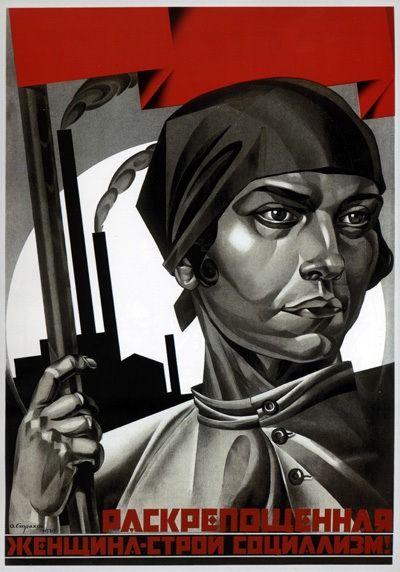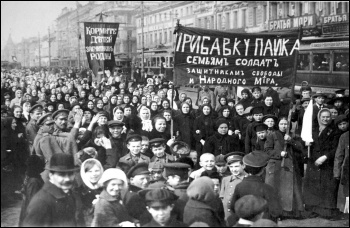Lessons of the Russian revolution for women’s struggle today
Corinthia Ward, Birmingham Socialist Party
The 1917 Russian revolution was a momentous moment in working class history, in which women played a pivotal and active role. It started with a strike by women textile workers on 8 March (International Women’s Day – 23 February according to the calendar in use in Russia at the time).
Not able to take their impoverished conditions and food shortages anymore, they took spontaneous strike action using the slogan “bread and herrings”. The women called on the metal workers to join them on their strike, to demand not only food but peace – an end to Russia’s part in the devastatingly bloody World War One.
The Bolsheviks (the party which led the movement of workers and peasants to overthrow capitalism and landlordism in 1917) recognised the need to address issues that specifically affected women and to free them from the burden of work in the home. This was made a key feature in the Bolsheviks’ political programme.
After the revolution, women experienced life like never before. Within a short time of the fall of the Tsar – under whose rule they had been severely oppressed and subject to a life of drudgery – women were able to access freedoms their counterparts in capitalist countries like Britain and Germany were years away from achieving.
Communal laundries and restaurants began to be established. They provided women with time each day that they had previously been robbed of, opening the possibility of families being able to spend quality time together, and for women to have more independence.
What may seem most surprising to modern audiences is that one of the benefits to come out of the revolution was free and legal abortions. Having control over their own bodies is still an issue many women are fighting for, even in what are regarded as ‘advanced’ capitalist countries, such as the US and Ireland.
Under Tsarism it wasn’t unusual for women to give birth on the factory floor. The fact that a relatively short time later they had access to safe abortion illustrates what progress can be achieved when workers have democratic control over the running of their society.
Other important gains for women included the right to vote, equal pay for equal work, and the start of free childcare nurseries. Marriage became merely a legal proceeding and either partner could file for a divorce.
The Bolsheviks understood it wouldn’t just be about giving women the same opportunities and rights as men but also about changing the sexist attitudes deeply embedded in society. In the cities and large towns, where many women had jobs in factories, the idea of women having lives outside of the family and of breaking from their ‘traditional’ roles gained support more easily, especially among younger women.
But in the countryside, the still largely feudal structure of society made it much harder to improve the lot of women. The Bolsheviks were determined to solve this by conscious campaigning to engage with women in the countryside, encouraging them to be active participants in creating a new society.
Zhenotdel
In 1919 the Zhenotdel, a special women’s department, was set up to concentrate on these issues with women’s ‘commissions’ to ensure women were involved at every level of both the Bolshevik party and society. The Zhenotdel addressed issues such as childcare, housing, public health and prostitution.
The department held conferences made up of working class and peasant women delegates. Young working class women were part of an outreach project with women in remote areas. Women were also seconded to other government departments and party work.
As most women during this period were illiterate, the Zhenotdel had to think up innovative ways to connect with them such as exhibitions, discussions and visual posters – as well as producing newspapers and journals for those who could read.
The efforts of the revolution meant every aspect of Russian life was being transformed, including sex and relationships. Young people began questioning expected personal arrangements and searching for new and meaningful ways to engage in living and relating to one another.
So what went wrong? Why is it that a country where women made important steps towards liberation in 1917, a hundred years later has recently passed legislation decriminalising domestic abuse?
The leaders of the Russian revolution from the beginning saw it as the first step in the struggle for socialism worldwide. They understood that the Soviet Union would not survive if it was left isolated.
If advanced capitalist countries like Britain and Germany had successful revolutions of their own, the huge resources of these countries could have been planned to meet the needs of all and to aid the development of socialism in the Soviet Union. But despite many big movements of workers inspired by events in Russia, this did not happen, due to the failings of workers’ and socialist leaders internationally.
The capitalist classes around the world quarantined Russia in order to starve socialism to death. By 1920 Russia’s output of manufactured goods was 12.9% of what it had been in 1913.
The post-revolution civil war and military attacks from capitalist, imperialist countries had ravished most of Russia’s wealth and killed millions of workers and peasants. Food shortages meant millions also died from famine – in 1919-1920 alone the figure was seven and a half million.
These conditions started to unravel the hard work done by the Bolsheviks and the working class, including through the Zhenotdel. In the city of Petrograd (St Petersburg) by 1923 58% of those who were unemployed were women.
Even though women were legally able to divorce, many could not afford to leave the ‘security’ of the family and were therefore forced to stay in unhappy marriages.
Communal restaurants were never opened as widely in the countryside and so remained non-existent for many peasants. And even the ones in the cities were losing support. Food shortages meant the food being provided was of poor quality, making many turn away from it.
The Zhenotdel, which had taken good initiatives in raising women’s consciousness and ensuring their needs were addressed by the party and the government, had started to disintegrate. Staff shortages and the effects of civil war meant the women who worked in the department themselves were exhausted and overburdened with work and family responsibilities.
In this situation it was inevitable that a bureaucratic caste would develop and take control, despite the heroic opposition of countless Russian workers, led by Leon Trotsky, one of the leaders of the revolution.
Stalinism
A small layer of the government, centred around Stalin, argued that rather than arguing for a socialist world, Russia should focus on developing itself alone. This bureaucratic elite was more concerned with maintaining its own position than working towards the democratic working class control of society.
Horrifically, any socialists who fought against this came to be witch-hunted by Stalin and his supporters.
The bureaucracy still presided over a planned economy, but did so in a top-down way instead of soviets (democratic workers’ councils) being in control. The economy grew stronger, but the bureaucratic elite creamed off huge wealth at the expense of the majority; and without democracy, the quality of goods and services deteriorated.
The Stalinist regime consciously worked to reintroduce the institution of the home with defined gender roles, in part to condition people into ‘knowing their place’ and not questioning authority.
The communal facilities and nurseries were deliberately starved of investment and support. Abortion clinics were underfunded to the detriment of women’s safety, which was then used as an excuse by the government to make abortion illegal once again.
Where posters had once been made to connect with illiterate women about liberating themselves, and artwork had depicted strong women for International Women’s Day, Stalin used propaganda which could be compared to advertisements in the US.
Women were portrayed as beauties holding flowers and International Women’s Day was turned into a day to buy the women in your life presents, not to remember the struggles women faced in shaping their society.
But in the early years of the revolution, a glimpse had been seen of what socialism could achieve, including for women. That has important lessons for today.
The recent ‘women’s marches’ against Trump in various countries showed an angry mood against sexism, and also a big sense of internationalism and solidarity among those fighting against oppression. This movement and all struggles against inequality and reactionary ideas must be linked to the fight for international socialism.
We need to criticise the current system and how it effectively places women as second class citizens in order to exploit them.
But what is also needed is to offer an alternative. It is within the very nature of a system divided by class to divide people in other ways and have some groups more privileged than others – women will always be among those who pay a price for this.
Socialist society
A socialist society would involve all people having a say in how their workplace, their town, and their world is run. Through democratic collective ownership of the biggest sections of the economy, we would be able to meet the needs of the majority rather than only the profits of the tiny few. These factors could begin to end all oppression and exploitation.
In order to win socialist change, we need the participation of the mass of the working class. The way forward for all those determined to fight for genuine equality for women must therefore include linking with the workers’ movement and fighting to end capitalism once and for all and to replace it with democratic, international socialism.
Further reading
- It doesn’t have to be like this – women and socialism by Christine Thomas £6
- The Emancipation of women by VI Lenin, £7.95
- Women and the Family by Leon Trotsky, £8.50
- A love of Worker Bees and A Great Love by Alexandra Kollontai, £18
- History of the Russian Revolution by Leon Trotsky £20
- Ten Days That Shook the World by John Reed, £6.99
- In Defence of October by Leon Trotsky, £1.00
- The April Theses by VI Lenin, £2.00
- National Liberation, Socialism and Imperialism by VI Lenin, £6.95
Add 20% postage
Cheques to ‘Socialist Books’
Available from leftbooks.co.uk
PO Box 24697, E11 1YD
020 8988 8789











